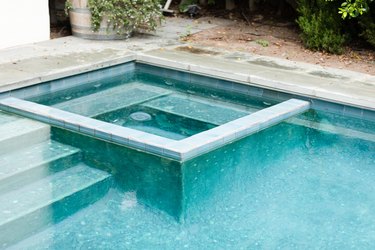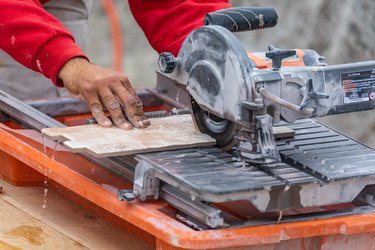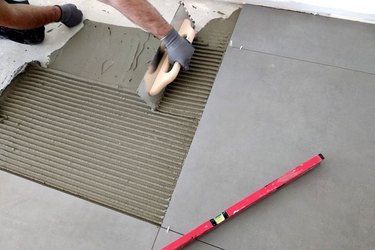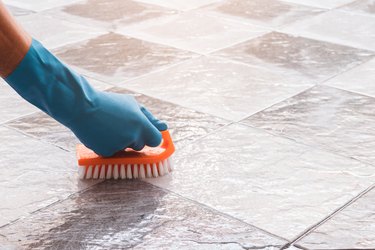
In This Article
If everything goes according to plan, you will be living with your new floor for many years to come. Porcelain tile is an excellent choice if you want a long-lasting, durable floor that's easy to clean. It also works well in kitchens and bathrooms where water-absorbing hardwoods and laminates tend to fall short.
Porcelain isn't likely to go easy on your budget, however, and it is a heavy material that requires a strong base. You'll want to look at porcelain flooring from every angle and make sure it is right for you before you make a commitment and start gluing tiles to your floor.
Video of the Day
Video of the Day
Porcelain or Ceramic Tile?
Although porcelain and ceramic floor tiles are similar, there are important differences you should know when floor shopping. Both are made from clay and are fired in a kiln, but the clay used to make porcelain tile is more refined and pure than that used to make ceramic tiles. Tile makers also fire porcelain at a higher temperature.
As a result of these differences, porcelain is much less fragile than ceramic tile. Porcelain also resists stains, scratches and moisture better than ceramic. Porcelain is far more likely to be a through-color product than ceramic as well. This means that porcelain is the same color throughout, making scratches much more likely to blend in with the floor. Ceramic tile, however, is typically one color on the surface and a different color underneath, making scratches far more noticeable.
Types of Porcelain Tile
When shopping for porcelain floor tiles, you will generally encounter three types. One is unglazed tile. Made by placing dry clay into a mold and firing it, unglazed tiles provide a more rustic look and a slightly textured matte finish for slip resistance. You can install and use some unglazed tiles as is, but you must seal others after installation to protect them from absorbing stains.
Far more popular are glazed tiles, which are coated in a liquid glass after being fired the first time and are then fired again. Glazed tiles are available in matte, semigloss and high-gloss finishes. High-gloss finishes get slippery when wet, however, and typically work better as wall tile than floor tile. Some glazed tiles are digitally printed. These tiles contain a photograph of marble, wood or other natural materials and look natural despite being man-made.
Lastly are full-bodied or double-loaded tiles. Made by joining two layers of clay together, the patterns and colors on these tiles run all the way through the material. This hides scratches or dings, making full-bodied tiles an excellent choice for high-traffic commercial settings.

Porcelain Tile Benefits
Porcelain tile floors can hide scratches because they are the same color throughout. Perhaps more important, though, is porcelain flooring's ability to avoid most scratches altogether. Both strong and durable, porcelain tile wears like iron and is an excellent choice in areas that see a lot of foot traffic.
Porcelain floor tile resists water as admirably as they resist scratches, making them an excellent choice for kitchens, bathrooms, laundry rooms and other moisture-prone areas. The material's lack of water absorption means you won't have to worry about an overflowing bathtub or leaking dishwasher ruining your floors. You also won't have to worry about your pets. Neither claws nor toileting accidents will damage porcelain flooring.
Because it is so sturdy, porcelain works well in areas with fluctuating temperatures and radiant heating systems. Some tile is even rated for outdoor use, and it can look perfectly at home there. Like other modern floors, porcelain can mimic the look of many other materials. You can opt for tiles with a wood look or enjoy the sophistication of travertine tiles without the hassle of caring for natural stone. If desired, you can even choose several different colors or styles of tile to create your own porcelain mosaic.
Porcelain Flooring Pitfalls
Unfortunately, nothing is perfect, and porcelain tile flooring does have some drawbacks. One is grout. No matter how perfectly you align your floor tiles, you will need to grout the floor. Porcelain tiles aren't porous, but grout is, so you will need to seal the grout well to keep it clean.

Keep in mind too that porcelain's toughness is great once you have the tile on the floor, but it can make getting it there more difficult. Cutting porcelain tile is challenging work that requires a wet saw with a diamond blade. Porcelain tile is also heavy, so it is important to verify that your subfloor can hold the weight.
When installing porcelain flooring, your subfloor needs to be as even as it is sturdy. Porcelain tile is rock solid when installed on an even subfloor but unforgiving on imperfect surfaces. Bumps, rough spots and uneven subfloors will cause your tile to break or crack. Because the installation of porcelain floor tile is so tricky, it is generally best to hire professional installers rather than attempting this project yourself.
Floor Tile Costs
According to HomeAdvisor, the average cost of porcelain tile in 2019 was $3 to $10 per square foot for indoor tile and $3 to $35 per square foot for outdoor tile. Professional installation can add $4 to $14 per square foot but is well worth the cost, given the challenges that installing porcelain flooring can present.
When considering the cost of porcelain flooring, remember to consider value as well. Porcelain tile may cost more upfront than other flooring options, but it is also likely to last longer. Mission Tile West reports that a quality tile designed to withstand high traffic can last 50 years when properly installed and maintained. Porcelain tile's longevity also makes it desirable, so you can enjoy the benefits of the tile while you live in your home and enjoy added value when it is time to sell.
Installing Porcelain Tile
Before you begin installing porcelain tile, use a self-leveling compound to smooth out your subfloor or install a cement backer board. You will also want to make sure you gather all the tools you will need, including a wet saw with a diamond blade for tile cutting. If you don't have a wet saw, you can most likely rent one from a local hardware store.
When you are ready, find the center of the floor and mark it with a chalk line. Begin laying out your tile at this center point, aligning it so that your center line will be a grout line. Lay out the entire floor using spacers to mark your intended grout lines. Begin adhering your tile to the floor only when you are happy with the layout and pattern.

Adhesion is crucial for proper porcelain tile installation, so be sure to spread your adhesive over the floor and butter the back of every tile before you apply it. When installing the floor, use spacers just as you did when laying out the floor to ensure even grout lines. Allow the adhesive time to set per the manufacturer's instructions and then grout and seal the floor. Don't rush the adhesive, as doing so can result in shifting tiles.
Cleaning Porcelain Flooring
Installing a porcelain tile floor can present some challenges, but keeping your new floor clean is a breeze. Because it doesn't absorb liquids, wiping stains off porcelain is easy even if you don't get to the job right away. To keep your floor looking spic and span, sweep or vacuum away dust as needed and mop with warm water and a mild cleanser when the floor show stains or gets sticky. If you encounter a tough stain, apply a little vinegar and scrub the area with a soft-bristled brush.
Porcelain tile is pretty tough, but there are some cleaning products you shouldn't use on your floor tile. Never use ammonia or bleach on your floor, as they can stain the grout and in some cases cause discoloration on the tile itself. Avoid scrubbing your floor with steel wool as well. Tiny pieces of steel wool can get left behind in the grout where they can eventually cause rust stains.
Dealing With Gross Grout
When it comes to floor tiles, it is important to understand that grout matters. The grout lines in your floor will be visible when the floor is done, and this can help enhance the look of the floor. Dirty grout, however, can really detract from your floor's appearance. Luckily, you can avoid grout problems by sealing new grout after it has had time to cure and set. Colored grout can enhance the aesthetics of your floor while helping to hide dirt better than white grout.
If you forget to seal your grout or find that it has gotten grungy after many years, you can fix the problem by applying a paste made from vinegar and baking soda to the grout and scrubbing it with a soft-bristled toothbrush. You can then rinse away your cleaner with warm water. If things are really ugly, you can remove the old grout with a special tool and re-grout your floor.
Both of these dirty grout solutions admittedly require a great deal of effort. They are well worth the time and energy, however, as they can greatly improve the look of a tired porcelain floor. When you are done cleaning, let the grout dry for a few days and then remember to reseal it. With proper sealing, you will have several years to rest before you need to clean your grout again.

Other Porcelain Tile Considerations
When considering porcelain tile designed to look like natural flooring material, keep in mind that computer-generated patterns will never be as random as nature. Manufacturers can imitate the veining found in marble and copy wood grain, but some of the tile boxes you get may contain identical tiles. Laying out the floor before you install it is a good way to make sure these tiles aren't positioned right next to each other.
It is also important to know that you can't fix broken porcelain tiles. Porcelain tiles don't break easily, but they are not completely indestructible. If one of your floor tiles does break, you will need to replace it or have a professional installer replace it for you. Fortunately, you can replace only the broken tile rather than having to replace your entire floor.
If you opt for a porcelain tile floor, consider buying an extra box of tiles when having your new floor installed. This way, you will have perfectly matched replacement tiles on hand if and when you need them in case the manufacturer stops making your particular tile style or pattern.
- HomeAdvisor: How Much Does It Cost To Install Ceramic Or Porcelain Tile?
- HomeAdvisor: Pros & Cons of Porcelain Tile
- Express Flooring: The Advantages and Disadvantages of Porcelain Tile Floors [Complete List]
- Better Homes & Gardens: Ceramic Tile & Porcelain Tile Flooring
- Pro Construction Guide: How to Install Porcelain Tile
- Better Homes & Gardens: How to Clean Grout: The Secrets to Success
- MSI: Tips from the Trade: How To Choose Between Glazed and Unglazed Porcelain Tile
- Johnson Tiles: Porcelain Tiles – A Detailed Guide